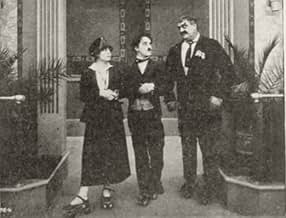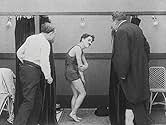Eric Campbell(1880-1917)
- Actor
Campbell was born in Sale, Cheshire on 26th April 1880 and began acting
as a boy. He married fellow music hall performer Fanny Gertrude
Robotham on March 30, 1901 and was later hired by English music hall
impresario Fred Karno for his "Fun Factory" comedy troupes that
featured other comics like a young Charlie Chaplin and Stan Laurel.
Campbell arrived in New York with a Karno troupe in July, 1914 and was
soon hired by Broadway producer Charles Frohman. In late 1915 fellow
Karno alum Chaplin and his brother Sid found Eric working in a George
M. Cohan play "Pom Pom" and in March, 1916, brought him to Hollywood.
Built like a wrestler, over 6' tall and over 250 pounds, topped by
small shaved head. Chaplin smeared his face with exaggerated eyebrows
and darkened eyes, with a scraggly and long beard. He was the menacing
bearded ogre opposite Chaplin in his most famous silents. His first
Chaplin film was The Floorwalker (1916), playing the role of the
villainous heavy, reprised in subsequent classics like The Rink (1916),
The Pawnshop (1916), The Adventurer (1917), The Cure (1917), The
Immigrant (1917), Easy Street (1917) and Chase me Charlie (1917). By
the summer of 1917 Campbell was Chaplin's favorite co-star and foil,
and almost as famous as the little comedian. In early 1917 Campbell
filmed his last Chaplin Mutual, The Adventurer, after which Chaplin
began construction on his own studio on LaBrea Avenue in Hollywood
(which still stands today). During the five-month construction period,
Chaplin lent Campbell to Mary Pickford, the world's biggest star, to
appear in her film Amarilly of Clothes-Line Alley (1917). He was on the
verge of becoming a world-wide star as filming began. But at the same
time that he was becoming famous his personal life was beset by tragedy
and scandal. On July 9, 1917 his wife died suddenly of a heart attack
after dinner at a Santa Monica restaurant near their home. Walking to a
nearby store to buy a mourning dress, his 16-year-old daughter Una was
hit by a car a seriously injured. At a September 12th party given for
Artcraft Studio publicity man Pete Schmid, Campbell met Pearl Gilman, a
diminutive vaudeville comedienne with a family reputation for
gold-digging. She had been married to candy heir Charles W. Alisky in
1912, and a few years later divorced and married another wealthy man,
Theodore Arnreiter. Her sister Mabelle was married to elderly steel
magnate William E. Corey, the owner of U.S. Steel. Just five days after
they met, Campbell and Gilman Alisky-Arnreiter were married at the home
of Elaine Hardy at 824 5th Street in Santa Monica. His daughter Una,
still recuperating at a friend's home in Santa Monica canyon, was not
told of the wedding for several weeks. Less than two months after
marrying the gentle giant, Gilman Alisky-Arnreiter sued him for
divorce. He moved out of the Santa Monica bungalow and into the Los
Angeles Athletic Club, taking a room next to his best friend Chaplin. A
month later later on December 20, Campbell attended a Christmas party
at the Vernon Country Club, and drove back to L.A. in a drunken stupor.
Approaching the intersection of Wilshire Blvd. and Vermont Ave. at over
60 m.p.h., he lost control of his car, crossed Wilshire and hit another
car head-on. He was killed instantly, his massive body locked in the
crumpled wreckage for over five hours. Heartbreak never left Campbell,
even in death. After his remains were cremated, his ashes were sent to
the Rosedale Cemetery, where they remained for six months while the
cemetery waited in vain for someone to pay for his funeral. When the
bill remained unpaid, the urn was returned to the Handley Mortuary,
where it sat unnoticed in a closet from 1917 until late 1938. When the
mortuary closed the urn was sent back to Rosedale, where it sat in
another closet for still another 13 years. In 1952 a kindhearted office
worker arranged for Campbell's remains to finally be buried. But,
unfortunately, he forgot to record exactly where Campbell was buried,
so the burly Scotsman is lost among the markers and statues in the
quiet cemetery. In conjunction with a Scottish film about Campbell's
life, a memorial plaque was laid in 1996. Campbell's death had a
profound effect on Chaplin, and a quieter effect on movie history.
After that time, Chaplin's movies lost some of their comic mystery;
that certain something that his Mutual films had but subsequent films
did not. His later works were much more self-centered and missing the
comic give-and-take of his work with Campbell. There's no telling how
famous Eric Campbell would have become, or what different films Chaplin
may have done with his burly best friend.



















